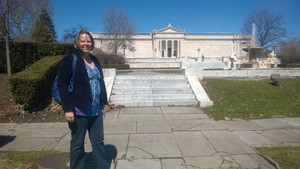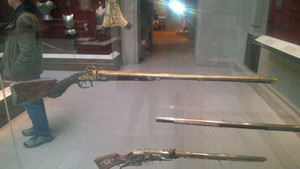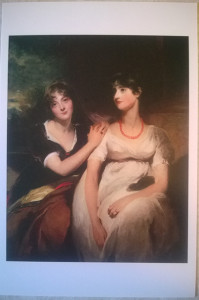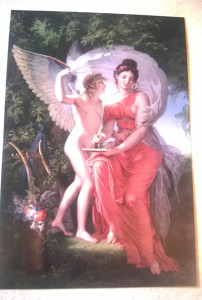 Over the Easter weekend, I visited the Cleveland Museum of Art with my youngest daughter and a dear high school friend. Although I grew up in Cleveland, I haven’t been to the museum in years, so it was fun to tour the galleries and have lunch at the Café. Their Tandoor Grill has nice curries, Naan bread and chutneys. Mmmm….
Over the Easter weekend, I visited the Cleveland Museum of Art with my youngest daughter and a dear high school friend. Although I grew up in Cleveland, I haven’t been to the museum in years, so it was fun to tour the galleries and have lunch at the Café. Their Tandoor Grill has nice curries, Naan bread and chutneys. Mmmm….
Here are a few items of Regency interest.
 The first item is in the Armor Court, an impressive collection of armor and weapons. Most of the collection is earlier than our period of course, but this “double-barrelled flintlock sporting gun” was made in 1809 for Napoleon Bonaparte. It was made by Jean Le Page, member of a family firm who supplied firearms to the French nobility. The description says such “deluxe” weapons were often made for display and as gifts and in this case, Napoleon did give this gun to a Polish count. Read more about Napoleon’s gun and check out the Cleveland in HDR blog for a closeup that shows more detail of the gorgeous workmanship.
The first item is in the Armor Court, an impressive collection of armor and weapons. Most of the collection is earlier than our period of course, but this “double-barrelled flintlock sporting gun” was made in 1809 for Napoleon Bonaparte. It was made by Jean Le Page, member of a family firm who supplied firearms to the French nobility. The description says such “deluxe” weapons were often made for display and as gifts and in this case, Napoleon did give this gun to a Polish count. Read more about Napoleon’s gun and check out the Cleveland in HDR blog for a closeup that shows more detail of the gorgeous workmanship.
I picked up postcards of the next two items. Although photography without flash was permitted, I didn’t want to risk the flash going off accidentally (I am clumsy) and often the pictures in the postcards are better anyway.
 Here’s one of my favorite Regency portraits, what my daughter likes to call “historical selfies”. It’s a portrait of Charlotte and Sarah Carteret-Hardy, by Sir Thomas Lawrence, 1801. Sarah was married the same year, Charlotte a few years later. The contrasting personalities of the two remind me of my own daughters—one more dreamy and introspective, the other more lively and outgoing. And of course the clothes are lovely. Here’s the link for more information on the Hardy sisters portrait.
Here’s one of my favorite Regency portraits, what my daughter likes to call “historical selfies”. It’s a portrait of Charlotte and Sarah Carteret-Hardy, by Sir Thomas Lawrence, 1801. Sarah was married the same year, Charlotte a few years later. The contrasting personalities of the two remind me of my own daughters—one more dreamy and introspective, the other more lively and outgoing. And of course the clothes are lovely. Here’s the link for more information on the Hardy sisters portrait.
And lastly, I was charmed by a series, “Apollo and the Muses” by the French painter Charles Meynier in 1800. They include Polyhymnia, Muse of Eloquence; Erato, Muse of Lyrical Poetry; Apollo, God of Light, Eloquence, Poetry and the Fine Arts with Urania, Muse of Astronomy; Calliope, Muse of Epic Poetry; and Clio, Muse of History. The one I’m showing here is Erato.
 Here’s a fascinating article on the restoration process. Restoring the Erato painting was particularly challenging, since another artist had over-painted Cupid’s body with a “prudish white veil” an estimated 75 years after Meynier completed the painting. Those Victorians! Fortunately, it was possible to remove the veil and restore the painting to its original beauty.
Here’s a fascinating article on the restoration process. Restoring the Erato painting was particularly challenging, since another artist had over-painted Cupid’s body with a “prudish white veil” an estimated 75 years after Meynier completed the painting. Those Victorians! Fortunately, it was possible to remove the veil and restore the painting to its original beauty.
On the CMA website, you can also see the individual paintings in the Apollo and the Muses series.
Have any of you visited the Cleveland Museum of Art? (I highly recommend it.) Do you enjoy stories of restored treasures?
Elena
www.elenagreene.com












